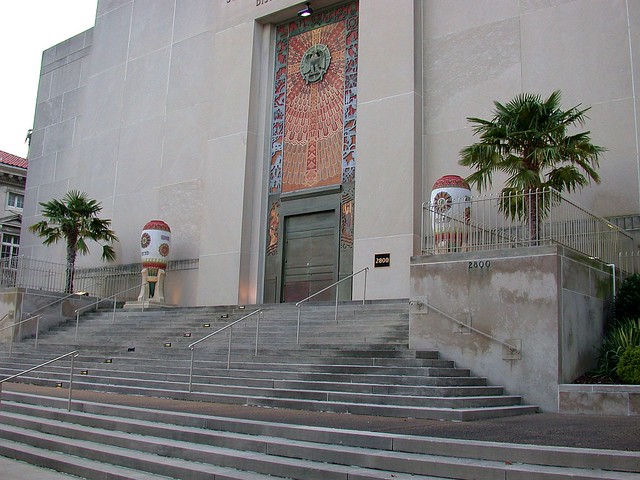
Scottish Rite Temple, October 2012
In early February, when we were in the middle of our coldest winter in a very long time, I wrote a blog post rounding up several windmill palms (Trachycarpus fortunei) that I've encountered in the city. Most of these palms were several years old and had suffered little damage from our recent mild winters but as I wrote in February, "...our coldest winter in 20 years will surely put these palms to the test. A general rule of thumb is that single digit temperatures are likely to cause damage, and temperatures below zero will cause massive damage and in many cases kill the palm outright (although duration of the cold is also critical). This makes windmill palms marginal in zone 7: sooner or later, they will experience temperatures capable of killing them."
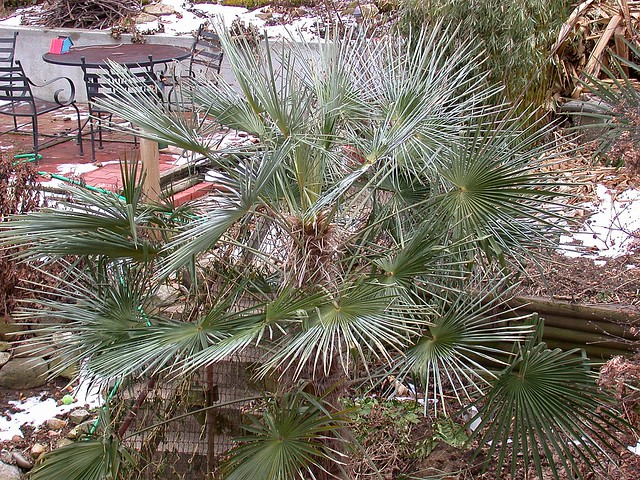
Trachycarpus fortunei "Bulgarian", early February 2014
In that blog post I bravely showed my "Bulgarian" as it looked at the time (above), going on to ask, "how many of these palms will still be alive this spring? After January lows of 5 degrees and below, many of these palms will be looking like my own in the photo above!" As it turned out, they all ended up looking much worse than that! So after our area's coldest winter in 20 years plus a bit of time to recuperate, it's time for an update on the windmills of Washington.
Following a decade of warmer-than-average winters, most local growers didn't protect their palms. Maybe they expected yet another warm winter, maybe they were fooled into thinking that windmill palms are hardier than they really are, or maybe they were just plain tired of the work involved in protecting a palm for the winter (which becomes increasingly difficult as the palm grows bigger). Some of the more hardcore growers have always eschewed protection. Aside from heavy mulching, I haven't protected any of my own palms since 2005, when my waggies were still small seedlings. While the hardier palm species (Sabal minor and Rhapidophyllum hystrix) generally came through this winter with little or no damage, in all cases the windmill palms suffered severe damage.
First, let's get my own palms out of the way; I'll keep this brief because I've already written about them (see What's missing from this picture?) In a nutshell, of my 3 windmill palms--T. wagnerianus, T. fortunei "Nainital" and T. fortunei "Bulgarian"--only the last one survived (see Bulgarian wins!). The palm had grown rapidly in recent years, attaining about 6 feet (ca. 2 m) of trunk by last fall (most of which is hidden by foliage in the photos below). Every frond eventually died, even the ones that were still showing some green at the end of winter, but the palm started pushing out new growth in April and even bloomed. Although the palm survived, the crown is still quite small and it will be quite some time before it looks anything like it did last year.

Trachycarpus fortunei "Bulgarian", early December 2013
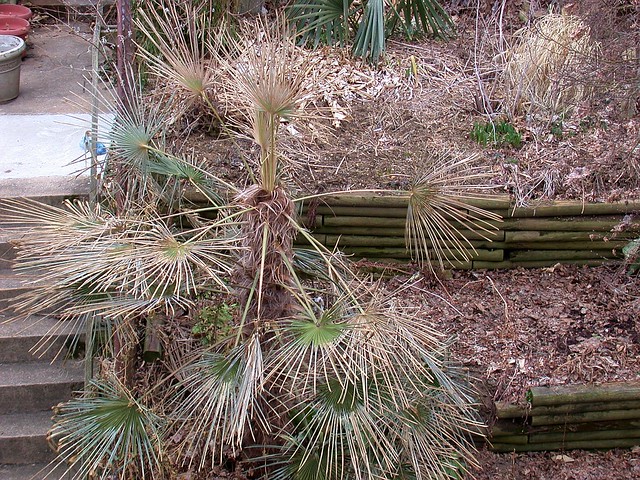
Trachycarpus fortunei "Bulgarian", March 2014
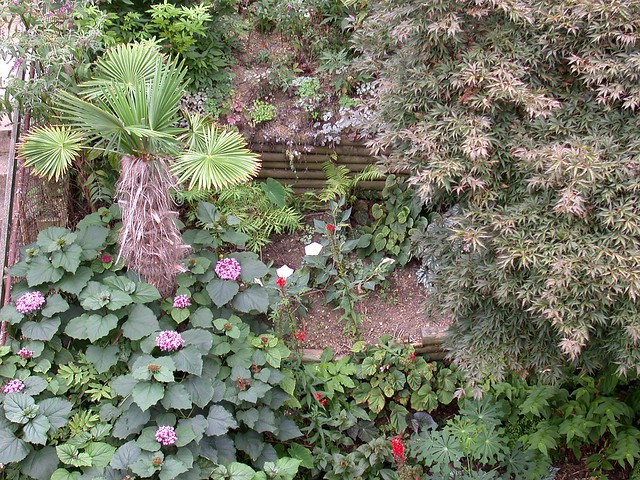
Trachycarpus fortunei "Bulgarian", late August 2014
One of the oldest windmill palms in the city was planted in a bed at the Smithsonian's National Air & Space Museum in 2000. This bed is interesting as a public example of all of the palms that are hardy in this area: needle palms (Rhapidophyllum hystrix) and dwarf palmettos (Sabal minor) in addition to the single windmill palm, and a hardy banana (Musa basjoo) as well. The palms in this bed have never received protection of any kind, but this spot is a bit unusual because it's situated over an underground parking garage that helps keep the soil from freezing. It's also on the south side of a large building in the heart of the urban heat island, giving this location one of the warmest microclimates in the entire city. Even so, the foliage was badly damaged but the palm survived and is recovering.
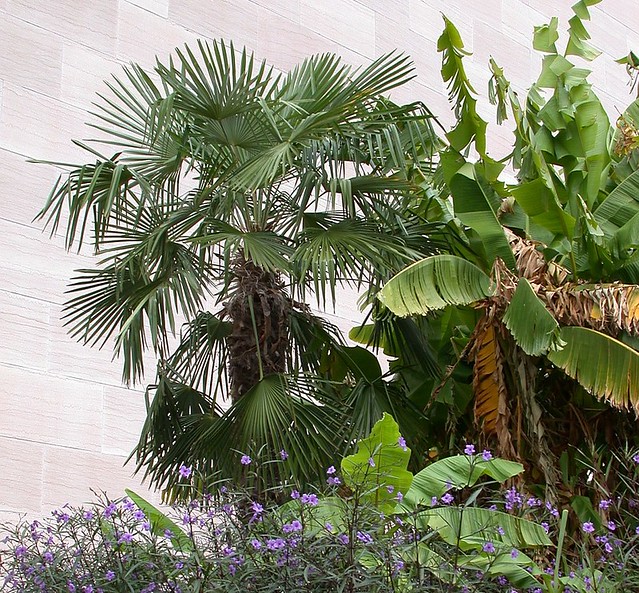
Trachycarpus fortunei, Air & Space Museum, October 2012
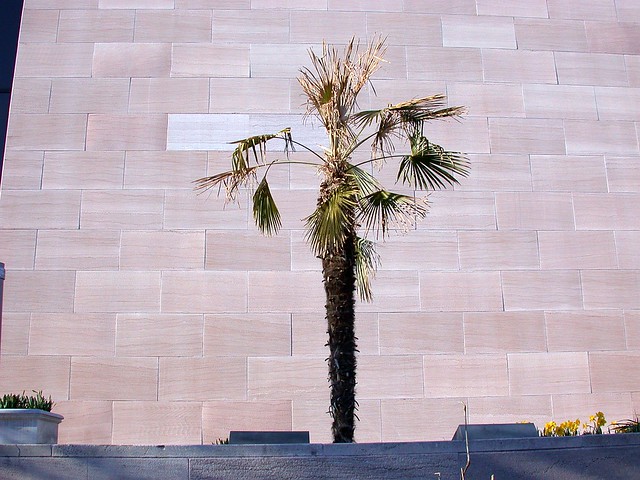
Trachycarpus fortunei, Air & Space Museum, late March 2014
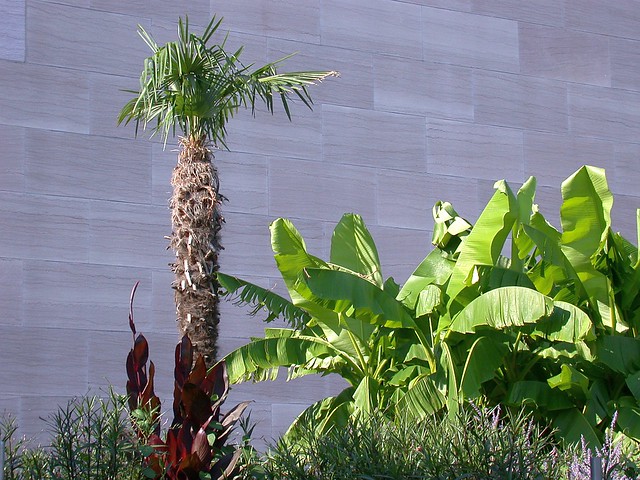
Trachycarpus fortunei, Air & Space Museum, July 2014
North of downtown, in a private front garden in the residential Shaw neighborhood, is a windmill palm that was planted about 6 years ago. I'm not certain exactly when it was planted, but it looked quite healthy when I photographed it in 2012. I walked by this palm a few days ago and was disappointed to see that it was dead. This was a bit surprising as this palm was planted in a very sheltered location, with trees, shrubs, and buildings on all sides. On closer inspection, it looks like it started to put out some new fronds this spring but subsequently died anyway. I saw something similar with my "Bulgarian": the first leaves that started pushing out, burned at the tips but green and healthy-looking at the base, ended up dying and pulling out, but were later replaced by healthy new fronds.

Trachycarpus fortunei, Shaw neighborhood, May 2012
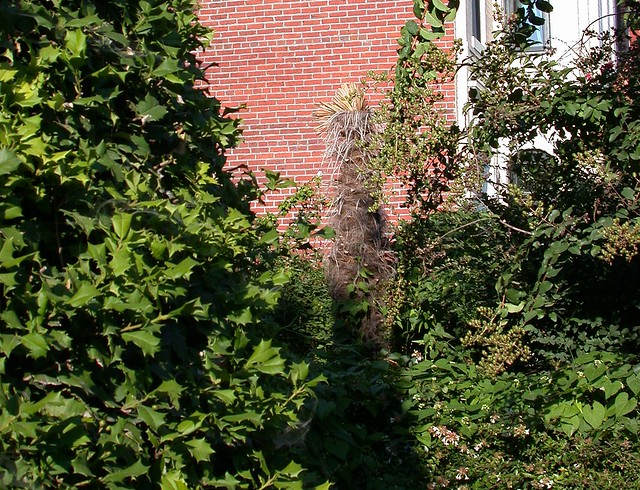
Trachycarpus fortunei, Shaw neighborhood, August 2014
Another disappointment was a palm in the Adams Morgan neighborhood. I first noticed this palm about 5 years ago and watched it grow rapidly over the next few years. I especially liked this palm because it had a full and healthy-looking crown and was in a very visible location, and also because it was just steps from the apartment where my partner (now husband) and I lived when we first moved to Washington in 1991. (Seriously, those are our old windows immediately to the left of the palm.)
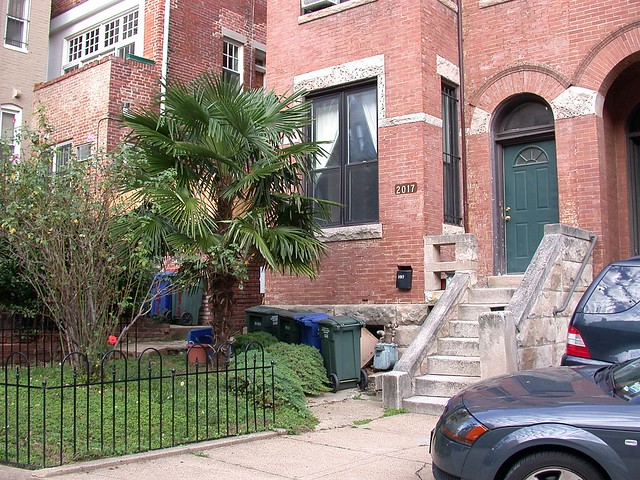
Trachycarpus fortunei, Adams Morgan neighborhood, October 2012
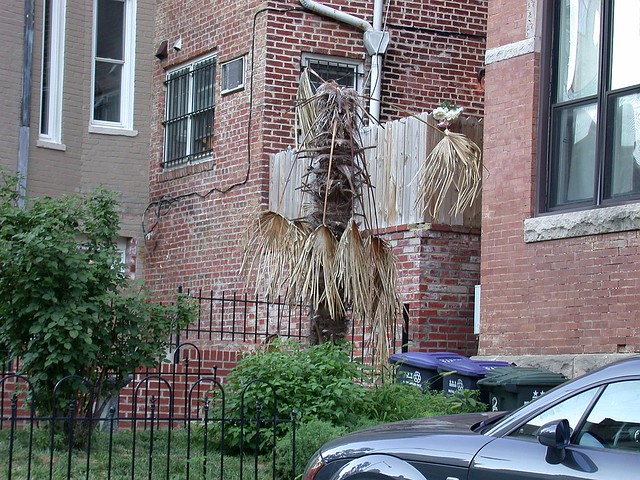
Trachycarpus fortunei, Adams Morgan neighborhood, July 2014
Not far from where I live now, a pair of windmill palms flank the entrance to the Scottish Rite Temple on 16th St. NW. There's a long story behind the palms at this location (see Saga of the Scottish Rite palms) but the current palms were planted in 2011. This was a case where I thought the building and the palms complemented each other very nicely, and I loved driving by these palms every morning on my way to work. In late January both palms looked considerably better than any of my own and I thought the massive stone building, and being on its downwind side, would provide some protection. Alas, the foliage fried anyway. Although one of the palms is clearly dead, I'm happy to see the other one recovering. I have no idea if the dead one will be replaced, or if both palms will be removed to plant something a bit more reliable.
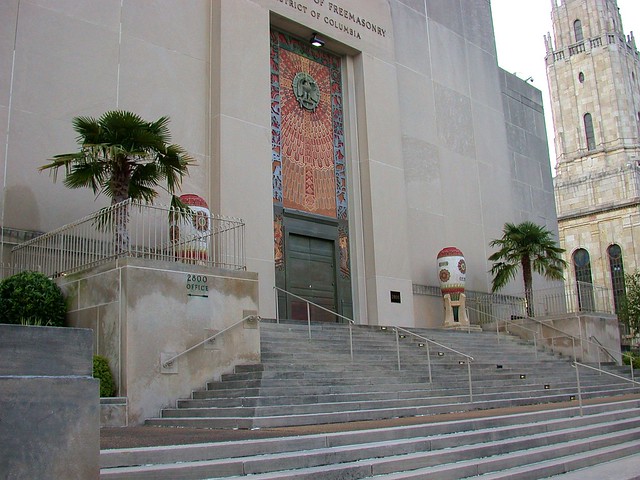
Scottish Rite Temple, October 2012

Scottish Rite Temple, late January 2014
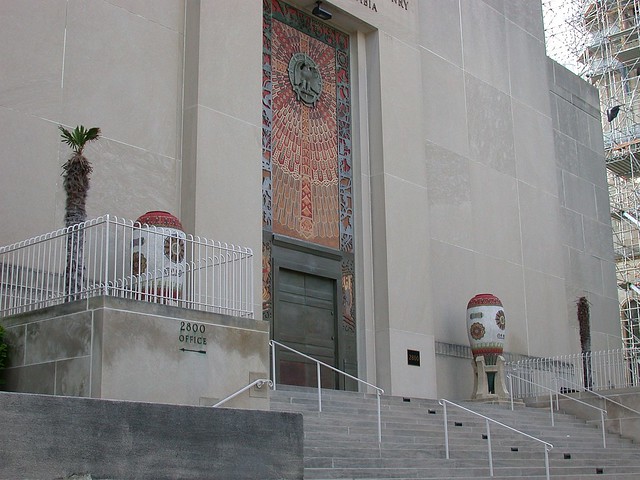
Scottish Rite Temple, July 2014
Finally, a look at the pair of windmill palms planted at the Smithsonian's National Museum of Natural History on the National Mall in downtown DC. These palms, planted in 2011, are near and dear to me because this is the building where I work, and because the Smithsonian gardener who planted them told me he was inspired to try them by a talk I gave in 2010 at the Smithsonian on growing hardy palms and other zone-pushing plants. As with the Scottish Rite palms, one of the palms died but the other survived and is recovering.
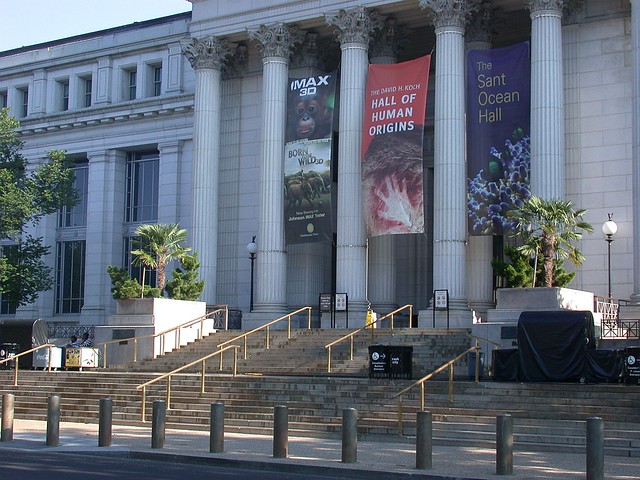
National Museum of Natural History, June 2011
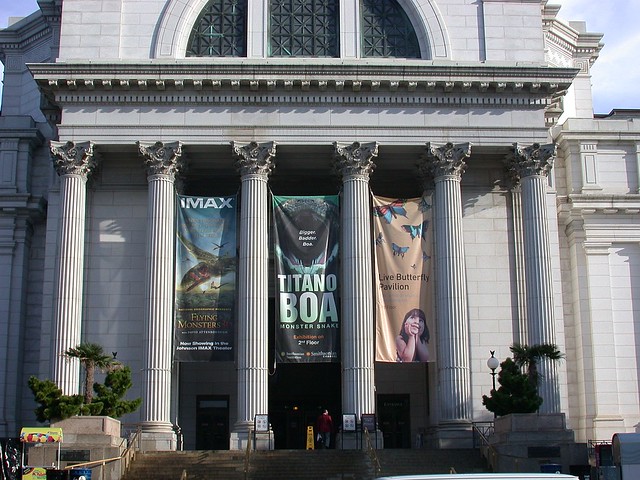
National Museum of Natural History, October 2012
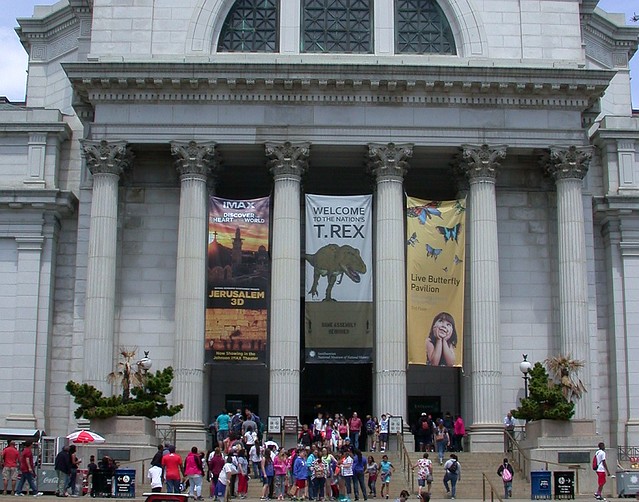
National Museum of Natural History, May 2014

National Museum of Natural History, May 2014 (closer look; dead)
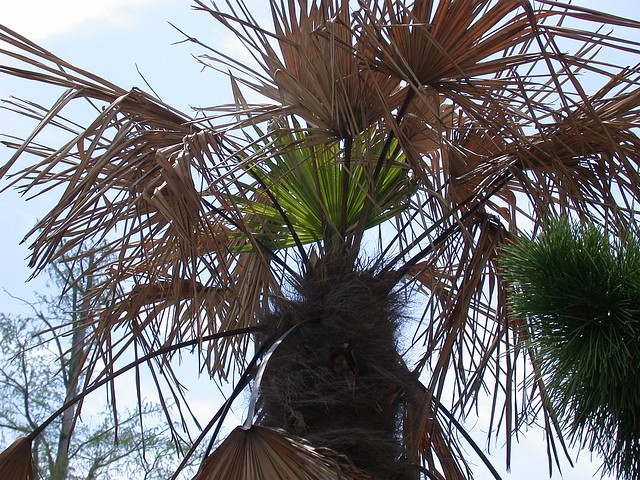
National Museum of Natural History, May 2014 (closer look; alive!)
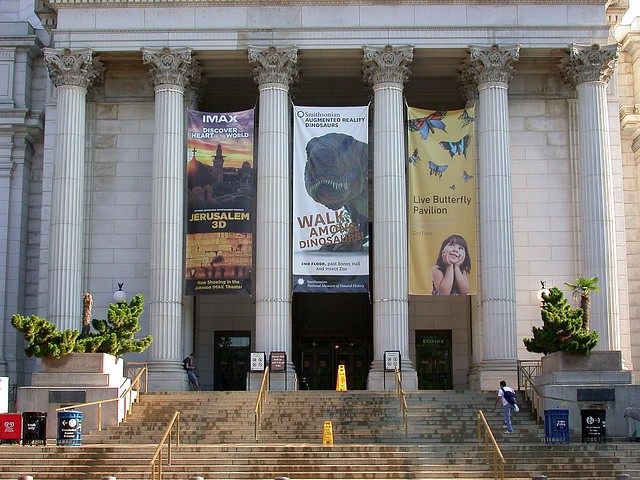
National Museum of Natural History, July 2014
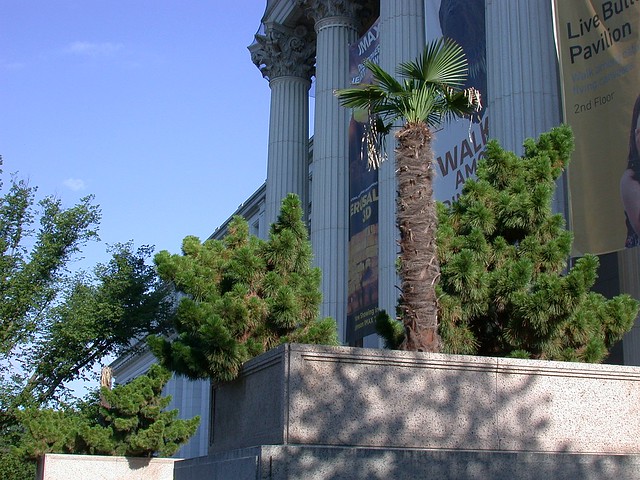
July 2014 (note dead companion in lower left background)
There have been many disappointments, but there have been some surprises. Earlier this year I thought for sure that a little windmill palm, tucked into a small garden near Dupont Circle, was dead. It has always been small and on the weak side, being planted in the shade and root competition of a very large oak tree, and has suffered winter damage even after mild winters. I never even bothered to photograph it, perhaps unconsciously writing it off even before this winter hit. When I saw it this spring, it looked just as bad as all the other windmill palms in the area but when I walked by it just a couple of weeks ago, fully expecting to document its death, it was pushing out a new frond. Although it survived, it has been severely weakened and I doubt it will survive another winter without protection. But who knows, I've been wrong before!
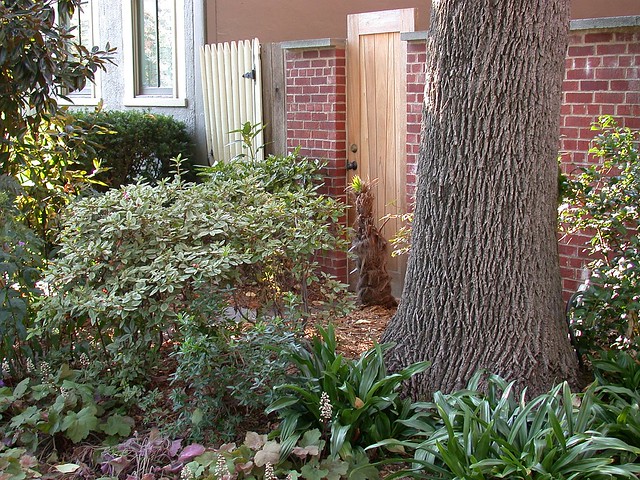
Trachycarpus fortunei, survivor near Dupont Circle
I don't yet have photos of the palms in private gardens outside the city; as in the city, all suffered major damage but a surprising number have apparently survived. I've heard that a venerable specimen in Silver Spring, one of the oldest and tallest windmill palms in the DC area, is dead; but in a private garden in Arlington with the best collection of hardy palms in northern Virginia, all but one of several windmill palms survived and are recovering. A beautiful specimen in Kensington defoliated, but survived and is recovering. Earlier this year I heard from a grower in Bethesda who lost several windmill palms. Ironically, this was one of the few local growers who attempted to protect his palms; protection can be counterproductive if it keeps the palms too warm, which I suspect was the case here.
I've been looking for patterns as to which palms lived and which palms died, and so far I don't see any. In two locations--the Museum of Natural History and the Scottish Rite Temple--one of each pair of palms died, while the other lived. Both pairs of palms were planted in front of a large building, in the same year, and it's interesting that the results were similar. Both members of each pair were the same age, same size, and seemed equally healthy going into the winter. So why did one palm survive, and the other die? Is there some underlying genetic variation in hardiness within the species, or is it ultimately random? I've wondered about this before (see Survival of the fittest?) and don't have an answer. Selecting for hardier strains of windmill palms is an interesting idea, and people are attempting to do so, but I would say the jury is still out.
In the meantime, I stand by my earlier assertion that windmill palms are marginal in zone 7. While it's encouraging that at least a few windmill palms survived this winter without protection, it's far too soon to be crowing about them. All of these survivors were severely damaged and whether they can make it through another winter in their weakened condition remains to be seen. The damage also demonstrates a pitfall for using windmill palms in public plantings: even coming out of a normal winter, a windmill palm can look pretty rough and can take several months to recover. While a gardener might tolerate a certain amount of damage every year or two in his or her private garden, knowing the palm will eventually recover, a palm that looks this bad for this long in a public garden is a problem. So while adventurous gardeners will probably continue to plant windmill palms in the Washington, DC area--and I hope they do!--I don't think we'll see many more being planted in public gardens or in other places where they are visible to the public.
I would love to hear from other palm growers in the Washington, DC area! Please post in the comments below whether your palms lived or died.

Thanks for the update. It was the same in N.J. My (3) trunked trachys died, having received only minimal protection. My winter low was +1, but there was an advective low of 2 or 3. many or most of the trachys on public property in Camden, Burlington, and Mercer Counties have died. A few started to grow and then died. A very few of the trunked trachys have substantial amounts of foliage that survived winter. I haven't done a tally yet, but perhaps a third are alive. The living ones have varying amounts of growth. The few with foliage were in very sheltered locations. There may be slight genetic differences in hardiness between different strains, but last winter obliterated initial differences. I've replaced a few and have plenty of gallon sized trachys to plant next spring.
ReplyDelete2/3 mortality is about what we had here as well. Your post emphasizes the importance of siting in a sheltered or otherwise favorable microclimate. It's surprising how much temperature can vary over just a few feet, especially when buildings are involved. But it's very encouraging that any windmill palms at all survived up your way! Thanks for sharing.
DeleteAppreciate the update and it is always sad to learn at the expense of those who have dreamed and planted.
ReplyDeleteThanks Loree, this is how we all learn and I don't regret it!
DeleteIf you are looking for local good news, my Windmill palm (T. fortunei) planted a s a seedling in Spring 2002 in Chevy chase DC, survived with severe damage. all the leaves fried, but the spear came in green. It receives no winter protection but is planted very close to the house, on the East side. Likely from insufficient sun, it has never flowered. The trunk is only about 5 ft. tall, with the leaves reaching 7-8 ft.
ReplyDeleteMy nearby sabal minor, planted at the same time farther from the house, shows no damage, It even flowered for the first time; are the fruit edible?
That is great news, thanks for sharing. I'm still looking for any patterns as to which palms lived and which palms died. Shelter and proximity to a building help immensely, but even that wasn't enough for some of our area palms.
DeleteSabal minor seems to be completely hardy here, although my own suffers mechanical damage (bending/breaking) from snow and ice. I don't know if the fruits are edible.
THE STERLING PALM????!!!!
ReplyDeleteI heard back from Mark H., who originally planted it in 1994 (although he no longer owns the property) and it is apparently very badly damaged but still (barely) alive. I only have this second hand--actually third, as I don't believe he has seen it either, and only heard from the current owner.
DeleteI lost a very healthy-looking 6' Trachycarpus fortunei. The palm was planted close to my house and surrounded by evergreen bushes. I mulched it but provided no additional winter protection. Nearby seedlings showed some burnt foliage but returned in June. Other palms - namely Rapidophyllum hystrix and Sabal minor - also showed burnt foliage but survived. Although I regret the loss of the large Trachy, I consider myself lucky, given my laissez-faire attitude!
ReplyDeleteAre you in the Washington, DC area? If so, I'm surprised you had any damage to your Sabal minor or Rhapidophyllum hystrix.
DeleteI'm in North Bethesda/Rockville, and both of my Trachies had 80% defoliation. Both are recovering. Both are planted close to the house.
ReplyDeleteMy Needle palm had no damage at all, and a Sabal Brazoria jammed against the wall in a pot survived with about 40% defoliation.
It still suprises me that many of these larger, more established palms in warmer parts of the area didn't do any better than my relatively small specimens out of downtown, north of the city. (In fact many did worse, since none of mine completely defoliated or died!) It's also sobering that we didn't even go below zero (which can and did happen south of here this year) and this is what we got! Duration matters, even for Trachies. On the other hand, it's possible that some these palms might have done better in a year where there were dips below zero , but no long durations of cold. I suspect the frequency/intensity of wind is a factor , too, and the timing of the cold after warm-ups as well.
Thanks for the info, it's very encouraging that any palms at all survived outside the urban core. I'm still not convinced that genetics has anything to do with some palms surviving where others didn't; I suspect there are many different factors involved that are just about impossible to control, like soil type or drainage, moisture, wind patterns, establishment or general health of the plant, etc. What really got us this year was the fact that (a) the extreme cold came very early in the winter, and (b) it was followed by several more cold periods--maybe not as low, but compounding the damage that was already done. I think the same cold later in the winter, or occurring early and followed by a relatively warm winter, would have made a big difference.
Delete